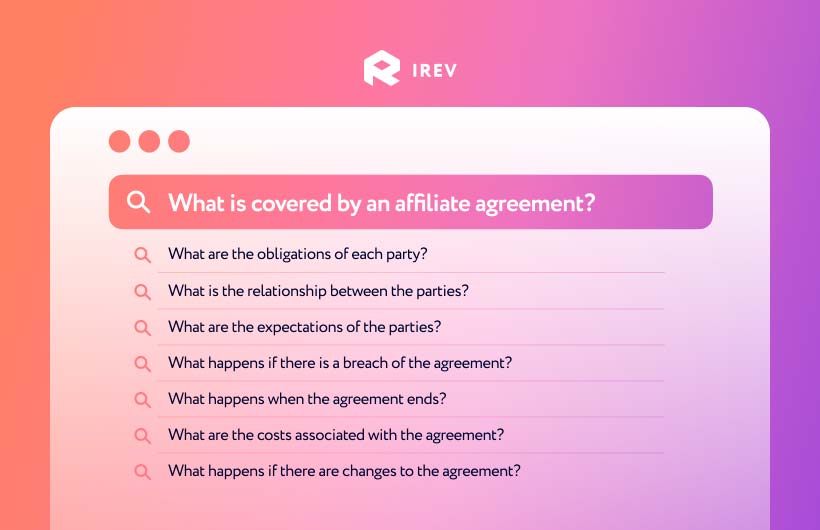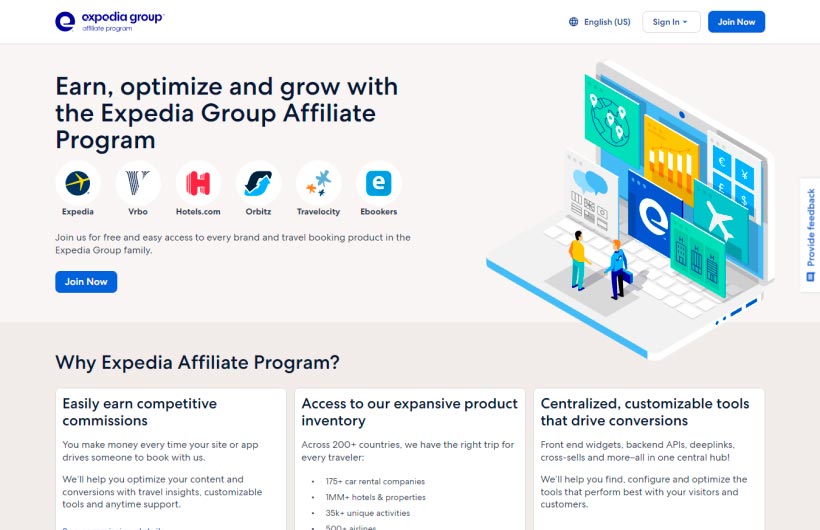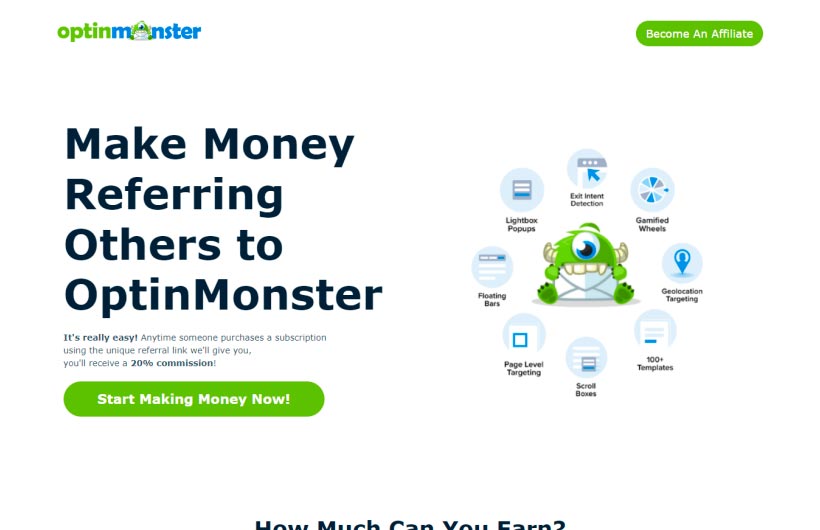

Affiliate Agreement Guide: Terms, Templates & Compliance for Your Program
Guide to Writing Terms and Conditions for an Effective Affiliate Program
Given that most products and services have their own affiliate programs nowadays, it is essential for businesses to create an agreement that details all the terms and conditions of an affiliate program. This will help both parties avoid any misunderstandings or disagreements in the future. Creating an affiliate program agreement not only protects both sides from potential legal issues but also offers a neutral third-party perspective on how the relationship will work.
Affiliate programs are beneficial for both businesses and affiliates as they offer a way for businesses to generate new traffic and sales without doing much and paying only for the final results. For example, if you run an online store, you might create an affiliate program, where users can sign up as affiliates and earn commissions driving traffic to your site from their own blogs, social media pages, or paid ads.
If you are interested in creating your own affiliate program, it is important that you understand what this entails so you can create an agreement with a partner before entering into an affiliate partnership. We have put together this article to give you a general overview of what makes up an affiliate agreement and how to go about creating one yourself.

What Is An Affiliate Program Agreement?
If you are running an affiliate program, you will need to create an affiliate program agreement, or simply said, terms and conditions for your affiliates.
An affiliate agreement is a legal contract that outlines the relations between you and your affiliates and sets out the details of their participation in your affiliate program. The agreement will help both program owners and affiliates understand what is required from them and what they can expect in return for their efforts. Particularly, the agreement outlines the responsibilities of both parties, including what type of content can be published, whether or not affiliates can use your brand’s logos and images, and potential performance metrics that could be met with incentives.
You should have a robust set of terms and conditions when launching an affiliate program to ensure it runs smoothly. By creating a document that clearly outlines the rules of the game, you can avoid future confusion and misunderstanding with affiliates.
Getting Started With Affiliate Program Agreement
When it comes to affiliate marketing, the primary concern of businesses is how they can protect their brand while developing a mutually beneficial relationship with affiliates. To achieve this, you need to create an affiliate program agreement that clearly details the terms and conditions for your partners.
To create an affiliate program agreement, you’ll first need to create a proposal document. This shows potential partners your vision for the program, including what incentives you’re offering and what measures you’ll take to protect your brand. Once you have this in place, you can begin writing the terms and conditions for your affiliate program agreement. Should you find yourself stuck at any point during this process, we have outlined some helpful tips below.
What Should Be Included In Affiliate Agreement?
There are a few key things to include when drafting an affiliate agreement. These are summarized below and further explained in the next section:
– Who are the parties involved?
– What are the obligations of each party?
– What is the relationship between the parties?
– What are the expectations of the parties?
– What happens if there is a breach of the agreement?
– What happens when the agreement ends?
– What are the costs associated with the agreement?
– What happens if there are changes to the agreement?
While each of these points may seem obvious in principle, each one is a crucial aspect of creating and running a robust affiliate program. These points will be the building blocks of your affiliate agreement; without them, you risk leaving important information out.

Who are the parties involved?
The first thing you should outline in your affiliate agreement is who the parties involved are. Provide a brief introduction of yourself and your company and then a description of your affiliates. Be sure to include their name, contact details, and a brief background of their experience (if any) in the industry.
What are the obligations of each party?
As the affiliate program manager, you are the one setting the rules for the program. That means you should also outline the obligations of your affiliates. These obligations could include expectations like the types of content affiliates create, where they publish this content, and how often they publish it. Your obligations, in return, may include providing an accessible way for affiliates to report their earnings and ensuaring an appropriate payment schedule.
What is the relationship between the parties?
Affiliate relationships come in all shapes and sizes, and that is why it is critical to outline the nature of the relationship between yourself and your affiliates. You can do it by creating a brief description of your relationship, such as “retailer and distributor” or “service provider and contractor”. The type of relationship will determine which party holds certain responsibilities.
What are the expectations of the parties?
Affiliate programs are built on the expectation that affiliates will drive traffic and sales to your site. Therefore, you should include an expectation that affiliates adhere to certain standards and produce a certain amount of new sales. You will want to outline how frequently affiliates are expected to publish new content, how long that content should be, and what type of content it should be. You will also want to define the type of traffic affiliates should be driving to your site. Be sure to outline what types of sales are counted towards their commission.
What happens if there is a breach of the agreement?
Affiliate relationships are built on trust. If one of the parties violates that trust, the agreement is considered to be breached. Therefore, you should outline steps parties should take if they feel they have been wronged by another party. It is important to outline this upfront to avoid hurt feelings or misunderstandings later down the line.
What happens when the agreement ends?
Affiliate programs don’t last forever, and when the time comes, you will need to end the agreement. Therefore, you must outline how you will end the program and when. Be sure to outline terms for terminating the agreement as well as for what happens to commissions and outstanding payments.
What are the costs associated with the agreement?
Affiliate programs entail costs. You will need to invest in creating and promoting your program, so it is important to point out what your affiliates are responsible for and what you will cover. This could be as simple as outlining what each party covers when it comes to social media promotion or as complex as outlining the breakdown of each monthly payment.
What happens if there are changes to the agreement?
As your affiliate program matures, you will undoubtedly notice that things change. New challenges arise, new technology becomes available, and new trends emerge. Therefore, you should describe steps to take when there is a need to make changes to the agreement. It may be as simple as explaining how you will communicate those changes to your affiliates or as complex as holding a vote among the affiliates.

Common Structure Of Affiliate Programm Agreement
Foreword
Short introduction of an agreement. In some manner, it is a way for a company to introduce itself, make a trusting impression, and tell what the next paragraphs are about.
Terms and Definitions
Here you can specify industry-specific terms that affiliates would repeatedly meet in the contract. It is up to you to decide whether to have this part and whether you need to describe all industry terms or only specific ones. You can also specify the two (or more) parties that enter into the agreement and when the agreement becomes valid for them.
Summary
Make a summary of the agreement, emphasizing the most important points to encourage potential new affiliates to keep reading and promise that they will find useful information, and not just legal labels.
Enrollment
In this part, you describe the profile of publishers that fit your product and vice versa, as well as empathize who would not be accepted to the program. This part is important to ensure brand consistency and avoid publishers that can harm your reputation.
Affiliate Disclosure
If you require affiliates to disclose themselves (what is highly recommendable & in some cases legally required), you do it in this clause.
Trademark Policy
Trademark policy is one of the most important parts as without it you risk having your traffic, sales, and leads stolen by trademark violators.
It is crucial to clearly define how your trademark can be used. The most common way of stealing traffic is through variations and misspellings of a trademark. Thus, you should warn that any usage of such variations in paid search campaigns, domain names, tags, and other names is strictly forbidden and would lead to immediate expulsion from the affiliate program. The same goes for any font, color, and logo modifications.
Policies on Promotional Methods
The most detailed part, probably also the longest one, where you elaborate on allowed methods of promotion. It is not that much of a legal obligation, but of adjusting to the brand and promotion strategy.
Some program owners inclose additional appendixes containing examples of banners, texts, videos, etc. Some will also have a brand book to refer to for promotional materials. Be very clear about which marketing methods are allowed and which are prohibited. Better do a detailed list rather than leave a place for misinterpretation. It refers to content marketing, emails, video, coupons & vouchers, social media content, PPC campaigns, mobile ads, behavior retargetting, etc.
Affiliate Rights and Obligations
The clause with affiliate rights and obligations contains the list of the expectations from affiliates and benefits they should expect to receive when fulfilling the above-mentioned expectations.
Merchant Rights and Obligations
A similar list of actions affiliates should expect from merchants.
Relationship of the Parties
In affiliate marketing, it is implied that affiliates are independent contractors, not in any way employees or business partners. Though it s rather obvious, it wouldn’t hurt to reinsure. Many program owners prefer to have this clause in their agreement to avoid any misunderstanding.
Warranties and Representations
Your affiliate program agreement should be set down, that once being accepted by affiliates, it means that they represent and warrant to program owner under all parts mentioned in the agreement.
Payment Policy
In this part, you specify affiliate commissions that you pay, frequency & methods of payments, and any other bonuses.
Disclaimer
The Disclaimer clause is a very common part where every program owner is recommended to make it explicit to affiliates that you offer no implied representations or warranties regarding your affiliate program and the products or services sold through it.
Liability
You should clearly state in your affiliate program agreement that you will not be responsible for any damages, losses, or revenue arising from the affiliate program.
Indemnification
In this clause, your future affiliates need to agree to indemnify, defend and hold harmless you, your company, any affiliates, and other parties against any losses connected with claims related to your affiliates’ websites, misrepresentations of warranties, or breaches of agreements, trademarks infringement claims.
Confidentiality
In this part, you state that all information you exchange with affiliates under this agreement only can be used only within the scope of the agreement. This intention is motivated by the goal to protect sensitive data relevant to businesses, customers, affiliates, and any other collaborators.
Remedies
You can claim remedies in case of affiliates violate the agreement. To make sure you actually can do it, you add this clause. In this case, you would be able to terminate the agreement immediately and demand compensation for losses.
Limited License
The non-obligatory clause that program owners include if they decide to give the limited and revocable right to their affiliates for the use of their text, logo, graphics, trademark, and other marketing materials.
Miscellaneous
This final section is used for any other rules a program owner needs to clarify. Very often they are about certain local or state legal requirements and restrictions.
Check the template created by AMNavigator. There is even an option to download several templates.
Examples Of Affiliate Program Agreements
WISE Affiliate Program

Tips While Creating Affiliate Program Agreement
Advertise the key points first
Similar to content stages for a sales funnel, the affiliate program agreement is the document that affiliates would carefully read once they make up their mind about joining your program. However, to attract affiliates to your program you need to step-by-step present it on your website.
You may consider making a brief list of key information and presenting it first to affiliates to get familiar with your program conditions.
Outline the benefits of joining your affiliate program
Primarily it is relevant to emphasize the payouts affiliates should expect to receive. However, there are other things that could make a difference in affiliate partnerships meaning that benefits could go much beyond the financial terms. This may include things such as access to your branded marketing materials, such as logos, images, and website assets, and a percentage of sales generated by the affiliate’s referred customers.
Outline affiliate requirements
Outline any requirements that an affiliate has to meet to participate in your programs, such as a certain number of visitors per month or a minimum commission threshold. You’ll also want to outline what happens if an affiliate doesn’t meet the requirements to remain an affiliate, such as demoting their status or removing them from the program completely. It is also recommended to outline the relationship between you and your affiliates, including what happens if there is a dispute between the two parties or if an affiliate or you terminates the agreement.
Outline relevant to remuneration issues
One of the first things affiliates are scanning the website for is commissions and payment conditions. Thus, you should definitely outline affiliate commissions, frequency, and methods of payments. Finally, you’ll want to outline what happens if an affiliate exceeds expectations and meets certain performance metrics. Are you willing to give extra bonuses for that? Tell your potential affiliates about it.
Check the example of how Writesonice does it.
Wrapping up
Affiliate relationships are symbiotic relationships that work best when the terms and conditions of those relationships are clear and easily understood by all parties involved. When you are starting to create your own affiliate program, it is important to outline the terms and conditions that affiliates can expect in order to ensure the program runs smoothly and is fair to all parties. These terms and conditions should include information like who the parties involved are, what their obligations are, what the nature of the relationship is, what the expectations are, and what happens if there is a breach of the agreement. When these aspects of the affiliate program are clearly explained, everyone understands what is expected of them, and the program runs more smoothly as a result.
The What, Where, Why, and How of Partner Programs
Partner programs are a much-discussed topic in the marketing world, but with good reason. They have the potential to be incredibly successful. Implementing a partner program can be a challenge, but it’s worth it. In this article, we’ll explore the pros and cons of partner programs, and whether they’re right for your business. As you read on, you’ll understand why and how partner programs can be so successful, and how to implement one in your own business.






